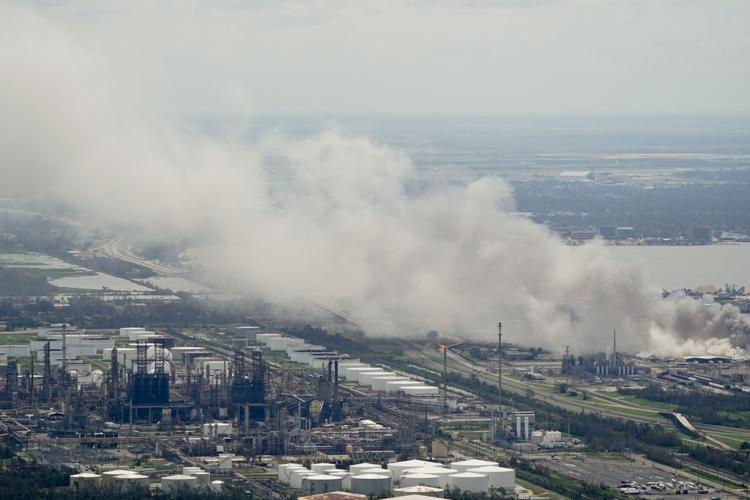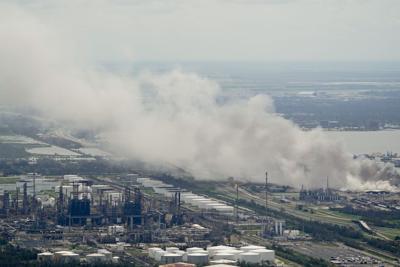The BioLab Inc. pool and spa chemical plant in Westlake, site of a massive fire and release of toxic chlorine during Hurricane Laura in 2020, was woefully unprepared for winds accompanying the storm and the resulting inferno that was unleashed, according to a new report by the U.S. Chemical Safety Board.
The board called for major upgrades in the construction of the company's new facility. The new plant was officially reopened in November, and the company says improvements have been put in place, though it is unclear to what degree.
In its recommendations, the board also calls for the federal Environmental Protection Agency and Occupational Safety and Health Administration to upgrade its regulations to assure similar accidents caused by natural disasters, including those resulting from climate change effects, don’t happen or can be quickly addressed.
And the report called on Louisiana officials to adopt similar upgrades in its rules, including requirements that existing and new chemical manufacturing buildings be built to withstand major hurricane-force winds.

Petrochemical and other plants are seen in background, as (lower left center) a chemical fire burns late Thursday afternoon at BioLab Inc. in Westlake, after Hurricane Laura passed over the Lake Charles area early Thursday morning, Aug. 27, 2020.
“With powerful storms and other extreme weather occurring more frequently, companies and regulators must take action to prevent weather-related releases of hazardous chemicals that can cause substantial damage to facilities and threaten surrounding communities," said board chair Steve Owens.
The BioLab incident occurred when Category 4 Laura severely damaged roofs and other portions of buildings at the plant, built in 1979 and never upgraded to present state building code wind standards, according to the report.

Forms of trichloroisocyanuric acid (TCCA) that were stored at the BioLab plant during Hurricane Laura. (Chemical Safety Board)
The plant manufactures trichloroisocyanuric acid, or TCCA, which contains up to 90% chlorine and used to sanitize swimming pools and spas. The product breaks down slowly into hyperchlorous acid, which kills bacteria, algae and other organisms.
In the aftermath of Laura, a small amount of water from rainfall hitting the material stored in dry form caused a chemical reaction that generated extreme heat, sparking fires in the BioLab buildings and releasing toxic chlorine gas.
On Aug. 27, 2020, when Laura hit, more than 1 million pounds of TCCA were being stored in BioLab buildings.

The BioLab Inc. complex on fire in Lake Charles is near I-10 in the Westlake area.
The Louisiana State Police shut down nearby Interstate 10 for 28 hours and a shelter-in-place order was issued for the surrounding community. No injuries were reported.
Five key issues
The CSB report identified five key safety issues.
- BioLab should have implemented emergency preparedness procedures recommended after a 2017 explosion at the Arkema pesticide manufacturing plant in Crosby, Texas, during Hurricane Harvey, also a Category 4 storm. BioLab's emergency water delivery system that was supposed to be available to fight a TCCA accident was also disrupted by lack of power and other issues, exacerbating the fire and gas release, the report found.

Crews train water late Thursday afternoon on the chemical reaction and fire at the sprawling BioLab Inc. complex in Westlake, just west of Lake Charles, which caught fire around 9 a.am. after Hurricane Laura passed over early Thursday morning, Aug. 27, 2020. Chlorine gas caused a shelter in place order to be issued.
- The TCCA chemical manufactured by BioLab is not covered by the federal Occupational Safety and Health Administration’s process safety management standard. While BioLab had voluntarily adopted some elements of it, the company did not implement one of its main recommendations: that it determine whether facility buildings could withstand hurricane-strength winds.

EPA's ASPECT monitoring aircraft captured this photo of gas and smoke rising from the BioLab building on Aug. 27. (Chemical Safety Board)
- BioLab employees were evacuated from the facility at 8:30 a.m. on Aug. 26, and the first company officials didn’t return until about 5 ½ hours after the storm damaged the building, “which likely increased the severity of the event,” the report said
- The CSB found the company didn’t follow National Fire Protection Association codes for high-hazard industries, including installation of automatic extinguishing systems or other equipment to minimize danger to occupants before they can evacuate.
- The CSB pointed out that the facility wasn’t required to implement baseline process safety management procedures required of other businesses by either OSHA or EPA because the TCCA chemical, though reactive, was not covered by either agency’s standards.
The report recommends that BioLab’s new buildings and structures be capable of withstanding hurricane winds and flooding and that it include other provisions in its workplace standards to assure hazardous chemicals aren’t released in the future.
“BioLab is deeply committed to the safety and well-being of the Lake Charles community and has already implemented numerous enhanced safety features at our newly reconstructed state-of-the-art facility, based on our own internal investigation,” the company said in a statement. “BioLab has worked collaboratively with the CSB throughout its investigation and has already considered its recommendations in the design and constructions of its new plant.”
The company declined to comment further. The $250 million reconstructed plant incorporates an elevated control room, a hurricane “ride-out” shelter and improved fire detection and extinguishing systems, the company has previously said.
Gov. John Bel Edwards and the chairs of the House and Senate environment committees, which oversee state Department of Environmental Quality regulations, did not respond to requests for comments. A DEQ spokesman said the agency is studying the report, while the EPA declined comment.

Aerial view of the BioLab Finished Goods Warehouses, showing holes in the roof where rainwater was able to reache chemicals inside. (CSB)
Similar incidents
KIK Consumer Products acquired Bio-Lab Inc. in 2013, but didn’t buy the Westlake plant until March 24, 2017. Bio-Lab operates a similar manufacturing facility in Conyers, Ga. According to the board, Occidental Chemical Corp. also operates a facility that produces, distributes or packages TCCA in Luling.
According to the board report, TCCA decomposition caused by exposure to rainfall is also linked to three toxic gas releases between 1988 and 2019 that forced evacuations and resulted in property damage. Another three TCCA incidents between 1998 and 2015 involved “an explosion, release of vapors, or chemical fire, causing injuries, environmental impacts, and evacuations." And another seven -- including one at Bio-Lab’s Conyers, Ga., facility -- occurred in 1999 and 2020 in warehouses or storage facilities and resulted in company employees, responders or others being sent to the hospital, being asked to shelter indoors or being ordered to evacuate.
The report did not mention a March 22 incident at BioLab in Westlake, where a chlorine gas leak was detected from a transfer line at the newly rebuilt facility, which prompted an order for people within a mile of the facility to shelter in place, and the shutdown of both lanes of I-10 near the plant.
When the BioLab facility was built in 1979, the Louisiana State Fire Marshal required they follow fire and building code standards in effect in the early 1970s, which did not include wind standards, according to the report.
The CSB found that in southwest Louisiana, those decisions were largely deferred to architects and engineers involved in large construction projects, but that they likely used the wind standards available at the time, which was about 100 mph for the Lake Charles area.
In 2006, a year after Hurricane Katrina, Louisiana adopted a uniform construction code provision that today includes use of the 2015 International Building Code wind standards, which would require BioLab’s buildings to withstand 145 mph winds.
The CSB found a similar construction timing issue with the state’s use of hazardous materials codes, which govern requirements for fire detection and automatic fire sprinkler systems. The present regulations require adherence to the latest rules for structures built or remodeled after July 1, 2017, but existing facilities, including BioLab, were grandfathered in to the codes in place at the time of their original construction.
“Had the BioLab buildings involved in the incident been equipped with automatic extinguishing systems, it is likely that Biolab would have begun applying large amounts of water on the decomposing TCCA earlier in the incident,” according to the report.
In a section aimed at Edwards, the state Legislature and the DEQ secretary, the report recommended that they require facility operators to evaluate for hazards from hurricanes, including ensuring that facilities – both new and existing – can withstand winds and flooding and also implement safeguards to ensure hazardous chemicals are not compromised or released.
The report also described delays workers ran into in first attempting to fight the chemical decomposition, with power outages and water pressure issues complicating the response.








